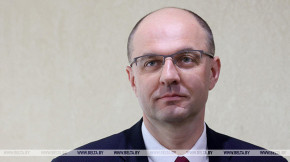Belarus working out new approaches to radioactive protection 37 years after Chernobyl catastrophe

A number of changes have occurred in the sphere of management of the post-Chernobyl situation. The operation of the Department for Alleviating Consequences of the Catastrophe at the Chernobyl Nuclear Power Plant has been discontinued. Tasks and functions of the department have been transferred to the Nuclear and Radiation Safety Department of the Belarusian Emergencies Ministry (Gosatomnadzor) and other government bodies. Work on Chernobyl-related problems will continue but in an updated format. Gosatomnadzor representatives came to BelTA’s press center to talk about the new approaches.
Gosatomnadzor Head Olga Lugovskaya explained why basic functions of the disestablished department had been transferred to Gosatomnadzor. “Our main task is to regulate safety at facilities where nuclear energy is used. At present the Belarusian nuclear power plant is our key facility. We’ve recently granted the permit to begin the reactor power startup stage as part of the process to commission the second unit. Now we will also work in a slightly different capacity. Chernobyl-related affairs are our field now, too. It is no accident. Radiation safety matters are directly related to consequences of the Chernobyl catastrophe. When we talk about efforts to ensure radiation safety, we mean we have to enable conditions for the safe life of people, for the safety of their health and the environment,” she remarked.
International documents, including the Nuclear Safety Convention, the Joint Convention on the Safety of Spent Fuel Management and the Safety of Radioactive Waste Management, define the existence of an independent regulatory body in the country. In Belarus this is Gosatomnadzor. “So, nuclear and radiation safety is our responsibility. And matters of forming a regulatory legal framework, establishing safety criteria are our tasks and functions. And the specificity of the Chernobyl territory is determined precisely by the presence of the radiation factor,” Olga Lugovskaya added.
The Gosatomnadzor head emphasized that the team has the necessary competencies to work on Chernobyl-related problems. “When the Gosatomnadzor team was formed in connection with the construction of the Belarusian nuclear power plant, the first employees were people deeply involved in Chernobyl affairs. They were specialists in the fields of radiation medicine, engineering related to the development of radiation monitoring devices, specialists in the field of nuclear physics. Both I and a number of my colleagues are graduates of specialized universities and had a direct connection to Chernobyl-related problems long before we joined Gosatomnadzor. So this topic is not totally new for us,” she pointed out.
Olga Lugovska stressed that today Belarus has established an infrastructure of nuclear and radiation safety and created a branch of nuclear law.
Gosatomnadzor Deputy Head of Grigory Astashko stressed that to ensure continuity and continue the work of colleagues is an important task. “But at the same time it is necessary to transform this work within the framework of our main mission, which is the regulation of nuclear and radiation safety. So now we are conducting a kind of analysis of legislation, of the situation in the sphere of normative regulation. We are weighing up our actions to the experience of the world community. First of all, we are coordinating with our closest neighbor, the Russian Federation,” he said.
According to him, active international cooperation on radiation safety is maintained. There are a number of international organizations that play a coordinating role in matters of normative regulation of radiation protection and work out recommendations. Grigory Astashko noted that representatives of Belarus make a worthy contribution to the work of such organizations.
“Today the main elements of the Belarusian legislation comply with international practice of ensuring radiation safety. It has been mentioned IAEA missions,” the Gosatomnadzor deputy head reminded.
“As for Chernobyl, the regulatory framework exists. The existing laws are closely interconnected, a clear system of interaction has been built. At the same time, we have begun to conduct a cross-section analysis of what needs to be adapted in these laws in terms of application practice and the latest changes in modern knowledge. The result of analytical work will be proposals for the subjects of legislative initiatives to include bills in their lawmaking plans,” Grigory Astashko shared the plans.
Head of Gosatomnadzor’s Radioactive Waste Management Office Dmitry Pavlov said: “Gosatomnadzor is expected to host a roundtable session soon with representatives of the Ecology, Nature Management and Chernobyl Catastrophe Commission of the House of Representatives of the National Assembly of Belarus. During the event we intend to present our vision of further development of legislation. We will suggest a concept for transforming approaches of the state to managing the contemporary post-Chernobyl situation in order to later on implement these approaches into legislation.”
The Gomel Oblast administration and the Mogilev Oblast administration now enforce restrictions on people’s access to the territories from which people have been relocated. “However, there have been no cardinal changes in the procedure for obtaining access to these territories,” assured Dmitry Pavlov.
The specialized enterprises Polesie and Radon, which are located in Gomel Oblast and Mogilev Oblast, have been transferred to municipal ownership. In accordance with a state program, these enterprises have been restoring order in the affected areas for decades. This work will be continued and will not go unnoticed by the regulator. “These enterprises have been licensed by Gosatomnadzor for activities related to the management of radioactive waste, as they service all Chernobyl burial sites located in Gomel Oblast and Mogilev Oblast. So these organizations are not out of our regulatory control,” the head of the Radioactive Waste Management Office said.
The most specific object in Belarus from the radiation point of view is the Polesie state radiation and ecology reserve. It was transferred to the Natural Resources and Environmental Protection Ministry. “This is an object of nuclear legacy, the Belarusian sector of the evacuation and exclusion zone created as a result of the Chernobyl catastrophe. It is clear that in terms of regulation, this object remains under the special attention of Gosatomnadzor. It is important to maintain the achieved level of radiation safety and prevent the spread of radionuclides outside the reserve,” Dmitry Pavlov stressed.
A government program on overcoming the consequences of the Chernobyl nuclear power plant catastrophe in the 2021-2025 period is being implemented in Belarus. An important task of the regulator is to coordinate all the activities of this program and participate in the Union State programs on this subject.
It is necessary to ensure radiation protection of the population and the implementation of protective measures in both agricultural production and forestry. The efforts also envisage coordination of planning of agrotechnical, agro-reclamation and other activities in the contaminated territories, coordination of operation of the republican system of radioactive contamination control, performance of radiation monitoring activities.
“It is necessary to obtain agricultural products that are normatively clean in terms of radionuclide content. To this end, a number of measures are being taken: acid soils histotization, application of potassium and phosphorus fertilizers, creation of improved lands for private farms, repair and maintenance work on melioration networks, radiation monitoring of soils of agricultural lands. And all this with full control of radioactive contamination of agricultural products. This control is exercised by the Agriculture and Food Ministry, the Healthcare Ministry, and the oblast administrations. Every year this information is submitted to Gosatomnadzor. Although our department has just now started implementing the Chernobyl-related tasks, we have used all this information for many years already when we had to prepare reviews of nuclear and radiation safety in Belarus. Work on preparing the reviews continues. We present them every year,” Dmitry Pavlov informed.
Gosatomnadzor also takes care of the safety of Chernobyl disposal sites. “Every year the Gomel and Mogilev administrations submit work plans to us, which we review and approve,” the head of the Radioactive Waste Management Office added.
Gosatomnadzor also coordinates work on ensuring the quality of drinking water and controlling its radioactive contamination.
Another direction is control of territories of population centers and facilities located in radioactive contamination areas. “In accordance with the legislation a list of settlements located in radioactive contamination zones is released once every five years. The last time the list was updated in 2021, it included 2,022 settlements. These settlements are home to 945,000 people. Every five years radioactive contamination maps for the country as a whole and for individual areas are also prepared,” Dmitry Pavlov said.
Gosatomnadzor is also responsible for equipping radiation monitoring branches. According to the Radioactive Waste Management Office head, the devices are supplied to the branches located in radioactive contamination areas, to veterinary and sanitary examination laboratories that work at marketplaces as well as to organizations involved in agrochemical, radiation monitoring of agricultural land. Deliveries are also made to organizations of the Belarusian National Union of Consumer Societies (Belkoopsoyuz) system that procure wild mushrooms and berries in radioactive contamination areas.
A separate layer of work is to examine the status of lands that are no longer used for agriculture because of the radiation factor. According to Gosatomnadzor, work in this direction will continue. “Since January 2023 the procedure for putting these lands into use has changed slightly. It allows transferring radiation hazardous agricultural lands into use for forestry purposes,” Dmitry Pavlov said.
Gosatomnadzor will perform the new functions in close contact with scientific and technical support organizations. This system already includes 18 organizations. Practical recommendations on radiation protection of the population under conditions of existing irradiation are being worked out with them now. Matters of management of radioactive contaminated areas in the remote post-accident period are also being considered. These recommendations will serve as a basis for further decisions.

